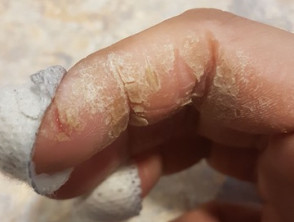What is hyperkeratotic palmar dermatitis?
Hyperkeratotic palmar dermatitis is a form of eczema in which there is thick scaling on the palms. Hyperkeratotic palmar dermatitis occurs without any obvious co-existing skin disease [1,2].
Hyperkeratotic palmar dermatitis is also known as hyperkeratotic hand eczema, hyperkeratotic eczema of the palms, and psoriasiform hand/palmar eczema.
Hyperkeratotic palmar dermatitis
Who gets hyperkeratotic palmar dermatitis?
Hyperkeratotic palmar dermatitis occurs more commonly in men than in women [2,3]. The age of onset tends to be later than in other subtypes of hand eczema, most often occurring at middle age.
What causes hyperkeratotic palmar dermatitis?
The cause of hyperkeratotic palmar dermatitis is unknown. It is classified as endogenous dermatitis [1–3]. Manual work is a risk factor for the development of hyperkeratotic palmar dermatitis, but patients do not generally report exposure to skin irritants or contact sensitisation [2,4,5].
Hyperkeratotic palmar dermatitis does not appear to be genetic in origin and there is no association with psoriasis or atopic dermatitis [1,5].
- The clinical features of hyperkeratotic palmar dermatitis and palmar psoriasis are similar, but there is no increased personal or family history of psoriasis.
- Human leukocyte antigens (HLA) associated with psoriasis are not increased in patients with hyperkeratotic palmar dermatitis.
- The incidence of personal and family history of atopic diseases is not increased in patients with hyperkeratotic palmar dermatitis.
What are the clinical features of hyperkeratotic palmar dermatitis?
Hyperkeratotic palmar dermatitis typically presents as sharply demarcated, hyperkeratotic, and fissured lesions in the middles of both palms. It typically starts in one palm and progresses to involve the other palm and the volar surfaces of the fingers. Hyperkeratotic plantar dermatitis may occur in some cases [1–3].
Patients usually report itching. Fissures, if present, can be painful [1,3]. There are no vesicles or pustules. Nails are not affected [2,3].
Painful fissuring in hyperkeratotic palmar dermatitis
How is hyperkeratotic palmar dermatitis diagnosed?
Hyperkeratotic palmar dermatitis is diagnosed clinically. The challenge is to distinguish between potential causes of palmar hyperkeratosis. Investigations may include:
- Skin scrapings, microscopy, and culture (see Laboratory tests for fungal infection) to exclude possible fungal infection (tinea manuum)
- Patch testing to exclude allergic contact dermatitis [2]
- Skin biopsy — note that histopathology cannot reliably distinguish palmar psoriasis from hyperkeratotic palmar dermatitis [6].
What is the differential diagnosis for hyperkeratotic palmar dermatitis?
Several skin conditions may be confused with hyperkeratotic palmar dermatitis.
Palmar psoriasis
- Psoriasis-type scale is usually absent in hyperkeratotic palmar dermatitis [4].
- Hyperkeratotic palmar dermatitis is usually itchier than palmar psoriasis [3,7].
Irritant contact dermatitis
- Irritant contact dermatitis is excluded by a negative history of exposure to relevant irritants.
- Irritant contact dermatitis is usually less localised and not well-demarcated [2].
Allergic contact dermatitis
- Chronic allergic contact dermatitis of the hands presents as thickened, scaling, and fissured dermatitis that can be difficult to distinguish from hyperkeratotic palmar dermatitis [8].
- Patch testing may detect a relevant allergen, such as nickel, chromate, formaldehyde, methyldibromoglutaronitrile, and sesquiterpene lactone mix [4,9].
Atopic dermatitis
- Hyperkeratotic phases can occur in atopic hand dermatitis.
- Unlike atopic dermatitis, hyperkeratotic palmar dermatitis is circumscribed, and has a later age onset than atopic dermatitis (which usually starts in infancy and childhood) [5].
Lichen simplex chronicus
- Lichen simplex is usually intensely itchy.
- Lichen simplex is more likely than hyperkeratotic palmar dermatitis to improve with topical corticosteroids [5].
Tinea infection
- Tinea manuum is usually unilateral.
- It is often associated with tinea pedis and tinea unguium.
- Tinea results in diffuse scaling or flaking of the palm instead of circumscribed hyperkeratotic plaques [7].
Other conditions to consider include:
- Lichen planus
- Pityriasis rubra pilaris
- Lupus erythematosus
- Keratoderma blenorrhagicum (reactive arthropathy)
- Syphilis
- Crusted scabies
- Keratoderma climactericum
- Palmar mycosis fungoides
- Acrokeratosis paraneoplastica.
What is the treatment for hyperkeratotic palmar dermatitis?
Compared to other subtypes of hand eczema, topical formulations are less effective in hyperkeratotic palmar dermatitis, resulting in a greater need for systemic treatment [11]. Acitretin has been found to be effective in the treatment of hyperkeratotic palmar dermatitis and often is useful at relatively low doses [12].
General measures
- Use appropriate protective gloves for all manual handling and for all wet work.
- Protective gloves should be intact, clean, and dry inside, and used for as short a time as possible.
- When protective gloves are used for more than 10 minutes, cotton gloves should be worn underneath.
- Avoid repetitive hand washing.
- Use a non-soap cleanser and make sure that hands are dried completely after washing.
- Note that cream cleansers are not antimicrobial; soap and water or a sanitiser is needed for washing hands in order to destroy pathogens such as the SARS-CoV-2 virus responsible for COVID-19.
Topical treatments
Topical treatment options for hyperkeratotic palmar dermatitis include:
- Emollients, especially greasier emollients applied at night and possibly applied under occlusion with cotton gloves
- Topical corticosteroids
- Topical calcineurin inhibitors
- Calcipotriol ointment
- Keratolytic agents
- Coal tar.
Physical therapy
Physical therapies for hyperkeratotic palmar dermatitis include:
Systemic therapy
Systemic therapies for hyperkeratotic palmar dermatitis include:
What is the likely outcome for hyperkeratotic palmar dermatitis?
Hyperkeratotic palmar dermatitis tends to follow a stable, chronic clinical course. Spontaneous resolution is uncommon [5]. Treatment with acitretin can result in a significant reduction in symptoms over a four-week treatment period [12,13]. This improvement has been shown to persist for five months after withdrawal of acitretin [13].
